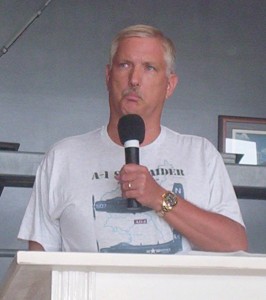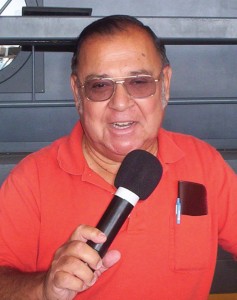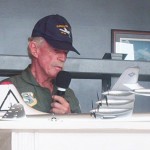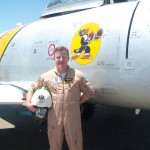By Fred “Crash” Blechman

Retired pilot Major Tom Richards described fighter tactics he used when flying the F-86 Sabre in Korea.
On the first Saturday of every month, The Air Museum Planes of Fame, located at Chino Airport, hosts a seminar featuring a particular aviation topic. On August 5, the subject was “Air War over Korea.”
The event, held in the large Enterprise hangar, began with a panel of speakers at 10:00 a.m. The panelists included a history teacher, a Sabre pilot, a B-36 tail gunner and an author. A flight demonstration followed a Q & A session. This month, the demonstration included two of the aircraft used in that “peacekeeping action,” a P-51 Mustang and an F-86 Sabre.
As usual, renowned aviation photographer Frank Mormillo acted as moderator. He first introduced Ed Maloney, Planes of Fame founder and curator, who made some brief comments. Next up was Gordon Bergslien, a 26-year-old teacher at Nogales High School in La Puente, Calif., and a docent for the museum since the early 1990s. He provided a summary of the events leading to North Korea’s invasion of South Korea in June 1950, described some of the action, and explained how the air war provided support for the greatly outnumbered South Korean and American troops.

Gordon Bergslein, a high school teacher and museum docent, provided a brief history of the Korean “police action.”
Tom Richards, who flew Sabre jets in Korea right after the armistice, spoke about the different models of the Sabre and their flying characteristics. Using small models, he demonstrated some fighter tactics. He showed how Sabre pilots operated the radar-operated gunsights, which contributed to the high ratio of Sabre kills to losses in aerial combat with Korean MiGs (often flown by Russian pilots). Richards remained in the Air Force Reserve, and flew many different single and multi-engine aircraft. Today, he flies his own Beech V-tail Bonanza.
Gilberta Guth, together with husband Howard Pierson, described her new book, “The Fighter Pilot’s Wife: A Military Family’s Story” (www.fighterpilotswife.com). Her late husband, Joe Guth, who passed away in 1998, was a Republic F-84 Thunderjet pilot in Korea, and went on to serve in the Air Force for almost 30 years, flying various fighter aircraft. For a time he was an exchange pilot with the Marines, and qualified as a carrier pilot.
The book contains many letters written by Guth to his wife, while he was on assignment in Korea and elsewhere, describing living conditions and flying. Pierson went through flight training with Joe Guth, and also has had a long flying career.

Museum aviation photographer Frank Mormillo moderated the panel discussion about the air war over Korea.
Jim Ash, a Convair B-36 Peacemaker tail gunner, brought along a large model of the huge B-36D 10-engine long-range heavy bomber (“six turning and four burning”—six huge piston engines drive 16-foot props and four large jet engines). He described in detail the various models and missions, and the duties of the crew of 15. Although the B-36 was never used in Korea, it was a strong deterrent during that period, keeping Russia from officially entering the Korean conflict—hence the name “Peacemaker.”
Mark Foster, museum vice president and general manager, flew the museum’s North American P-51D Wee Willie II in several tight turns over the museum area. Chris Fahey made several passes over the field and a couple of touch-and-goes in the museum’s North American F-86F Sabre.
Upcoming seminars include “Warbirds Forever!” (Sept. 2), “Naval Aviators” (Oct. 7), “Aviation Pioneers” (Nov. 4), and “Veterans Day” (Nov. 11), for which veterans will be admitted free.
At all of the seminars, museum members are admitted free, while others pay general admission. The museum houses dozens of aircraft (many flyable) in several hangars, and is open seven days a week, from 9 a.m. to 5 p.m. (except Thanksgiving Day and December 25). General admission is $8.95, $1.95 for children ages 5-11, and free for children under 5.
For more information, call 909-597-3722 or visit [http://www.planesoffame.org].
- Retired pilot Lt.Col. Howard Pierson and Gilberta Guth spoke about the late Joe Guth, the subject of “The Fighter Pilot’s Wife.”
- Ed Maloney is the founder and curator of The Air Museum Planes of Fame, founded in January 1957.
- Using a model of a B-36D, Tim Ash described the various models and missions of the Convair Peacemaker during the 1950s.
- Following the seminar, Mark Foster, museum vice president and general manager, flew the museum’s P-51D. Many P-51s were used in Korea for air-to-ground attack. Note that this P-51 has been modified for a small passenger jump seat behind the pilot.
- Chris Fahey flew the museum’s F-86F Sabre. The F-86 was the primary interceptor of MiG-15s during the Korean conflict.
















